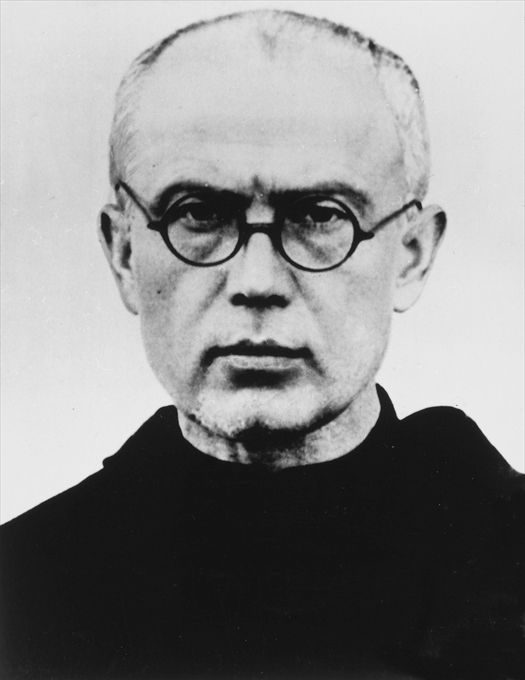As the storming German army approached, Kolbe and about forty of his Franciscan brothers eagerly awaited its impact. Despite the warnings of Polish officials, these men had decided to plant their feet in an almost deserted monastery. The Franciscans continued to remain prayerful and hopeful as German forces rapidly made their way towards the monastery. By the nineteenth of September, the German army had reached the city of Niepokalanow, where Kolbe and his brothers were residing in their monastery. Swiftly following an order given by their commanding officer, German soldiers rounded up Kolbe and his fellow Franciscans, and they were loaded into trucks that were destined for Czestochowa. When the trucks reached the city, the Franciscans were loaded onto a train, along with around six hundred civilian prisoners. As the train sped towards the German border, its passengers were unsure about their future. The passengers, or more specifically prisoners, could only assume that their destination would most likely be accompanied by pain and hardship. When the train arrived at the concentration camp of Amtitz, the prisoners were unloaded and sent to take their place within an already established system of humiliation. Although the treatment of prisoners at the concentration camp of Amtitz was wretched, the Nazi regime had not yet issued its exterminatory policy towards its prisoners. After a long and grueling few months, a commandant gathered three hundred prisoners, including the Franciscans, and informed them that they were being sent home. When they arrived back home in Niepokalanow, they found their city in shambles, and their church crippled by the plundering of the German army. Although they felt disappointed that a place of worship had been treated with such irreverence, they were still thankful that they had simply made it home alive.2

Back at home, Kolbe wasted no time as he voiced his condemnation of the acts of the Nazi regime. He wrote relentlessly to the authorities and demanded that justice be served to those who took advantage of the less powerful. He called for the resumption of the services provided by the monastery. This meant that he not only openly published his sentiments against the Nazi overlords, but also served the less fortunate in his community. For months, the monastery became a place of refuge and assistance for the local people. As 1940 began, the Nazis were demanding that they receive control of the fate of Poland. They had not yet waged war against most of Europe. Simultaneously, Kolbe’s reach grew and extended to refugees outside of Niepokalanow. Many fleeing Jews took refuge within the sanctuary that Kolbe had established. Kolbe’s actions were pushing him further into direct opposition with Nazi Germany, which had an overwhelmingly anti-Semitic agenda. With each generous act of charity, Kolbe moved one step closer to his fate. As the German army started to make its way into Nirpokalanow, slowly creeping closer and closer to the monastery, Kolbe and his brothers remained firm in their beliefs and practices, regardless of the fact that they were very quickly becoming a threat in the eyes of the opposition. Many encouraged Kolbe to escape while he still had a chance, but Kolbe only persisted in prayer and in open disapproval of the Nazi regime. By early 1941, the coexistence of Kolbe and the intruders could last no longer, and the German army gave Kolbe an ultimatum. German officials offered Kolbe German citizenship, which would allow his integration into the Nazi regime. If he declined this offer, he would become an enemy of Nazi Germany, and face the repercussions of his resistance.3 Without hesitation, Kolbe refused allegiance to Nazi Germany and therefore accepted the possible consequences that might incur. On February 17, 1941, Kolbe received news that German soldiers were making their way towards the monastery. Hearing this, he dressed in his Sunday habit and made his way to meet them at the entrance of the monastery. As the men approached, Kolbe greeted them by saying, “Praised be Jesus Christ,” and invited them inside. After showing them around the monastery, the soldiers announced that he was being arrested. Kolbe, without hesitation, handed himself over to his captors, and they departed.4
This time Kolbe was taken to Pawiak Prison in Warsaw, Poland. Upon his arrival, Kolbe was placed in a holding cell with many different people. Shortly after, the prisoners were evaluated and moved to separate cells. Although this setting kept Kolbe secluded from others most of the time, he took advantage of every opportunity to interact with his fellow prisoners. He was inspired to use every opportunity he had with others to teach them about his faith and to bring a sliver of joy to their bleak reality. Kolbe’s mission had its repercussions in the form of repeated beatings by Nazi sergeants.5 They took every opportunity to display their power and superiority, and jumped at the chance to take out their hatred on religious people. After a short stay at Pawiak, Kolbe was given the news that he was being relocated to Auschwitz.6
Auschwitz was a place where people went to die, either quickly or slowly. The only variation in the fates of the prisoners came through how they would perish. Would it be by starvation, exhaustion, torture, or mass execution? Only time would tell. Auschwitz ran on a perpetual cycle of extermination: prisoners were used for labor and experimentation, and subsequently thrown away like useless objects. The malnourished captives constantly had the misery of their reality enforced by psychotic guards who were encouraged to torture and abuse the prisoners to the furthest extent. Kolbe would reside in this dark and grim world for the last few months of his life. The love in his heart illuminated his surroundings and touched anyone who had the privilege to interact with him. Kolbe continued his ministry by talking with those incarcerated with him and bringing them the Word of God. Those who conversed with Kolbe at this time described him as an unfathomably joyous man. Prisoners who observed him from afar were overwhelmed by the compassion Kolbe showed to everyone he met. No one could understand just how someone could put the needs of others so far above their own. Because of his charitable actions and religious status, Kolbe was often singled out for extensive amounts of torture.7

On the last night of July, in 1941, alarms sounded signaling an attempted escape. A baker from Warsaw had escaped the camp and was evading the authorities. Whenever a situation like this would arise, the guards would be given the order to select ten prisoners to be starved until the escapee was found. However, this procedure was a lie. Those chosen would never be spared, even if the prisoner happened to be found. The following evening, Commandant Karl Fritsch announced that he would be selecting ten individuals to be starved to death. Among the group that was chosen was a man by the name of Francis Gajowniczek. When he was chosen, he began sobbing with despair and cried out that he had a wife and children. Without hesitation, Kolbe took a few steps forward and informed the prison official that he would like to offer himself in place of Gajowniczek. The German official asked him his profession, and Kolbe responded that he was a priest.8 The German official approved, and Gajowniczek was told to return to his place in line, with the others who had been spared. With that, Kolbe and the other unfortunate prisoners were taken to a bunker in Barrack 11 to be starved. The bunker was a desolate and cold place, and the prisoners were ordered to strip naked. Over the following days, the prisoners’ bodies would slowly deteriorate as dehydration and starvation set in. Within days, most of the group had perished, and the ones left were experiencing hallucinations and constant, severe anguish. However, those who passed by the bunker later claimed that Kolbe seemed to be exempt from these ailments. Indeed, he was reported to be in a constant state of meditation and prayer. When a fellow prisoner would pass, he would pray over them. After fourteen days, the prison guards were ordered to clear the prison cell. Seeing that Kolbe was still alive, a guard was ordered to inject Kolbe with a syringe of phenic acid. It is said that Kolbe extended his arm and willingly accepted his fate.9
It would be thirty-five years before Catholic Church officials would discuss the status of Kolbe within the church. Pope John XXIII was charged with the task of declaring if Kolbe would be considered a white or red martyr. White martyrs are those who choose to let their worldly pleasures die in order to take on a life of minimalism. Red martyrs are those who give their actual life in service to their faith. Pope John XXIII decided to declare Kolbe a white martyr. He felt that Kolbe’s actions were heroic, yet argued that they fell short of the actions typically associated with red martyrs. This action was later modified during the papacy of Pope Saint John Paul II, who canonized St. Maximilian Kolbe on October 10, 1982, and officially declare him a red martyr. Present at the canonization was Francis Gajowniczek, who was ninety-four at the time. The selflessness and courage of St. Maximilian Kolbe is a relatively modern example of an individual who did not waver in the face of persecution. Kolbe demonstrates the epitome of what it means to be a faithful servant of both one’s fellow man and God. His contribution to others didn’t end with his decision to sacrifice his life for another, and it continues to inspire those who hear his story to strive to live with humility, faith, courage, and love.10

- Andre Frossard, Forget Not Love (San Francisco: Ignatius Press, 1991), 157,158. ↵
- Andre Frossard, Forget Not Love (San Francisco: Ignatius Press 1991), 158,159,160. ↵
- Andre Frossard, Forget Not Love (San Francisco: Ignatius Press, 1991), 171,172,173,174. ↵
- Robert Royal, The Catholic Martyrs of the Twentieth Century: A Comprehensive World History (New York: Crossroad Pub Co., 2006), 206,207. ↵
- Andre Frossard, Forget Not Love (San Francisco: Ignatius Press, 1991), 175,176,177,178,179. ↵
- Robert Royal, The Catholic Martyrs of the Twentieth Century: A Comprehensive World History (New York: Crossroad Pub Co., 2006), 206. ↵
- Tejvan Pettinger, “Biography of Maximilian Kolbe,” Biography Online, August 3, 2014, https://www.biographyonline.net/spiritual/maximilian-kolbe.html. ↵
- Richard P. McBrien, Lives of the Saints: from Mary and St. Francis of Assisi to John XXIII and Mother Teresa (San Francisco: HarperSanFrancisco, 2003), 328,329,330. ↵
- Andre Frossard, Forget Not Love (San Francisco: Ignatius Press, 1991), 193,194,195,196,197. ↵
- Andre Frossard, Forget Not Love (San Francisco: Ignatius Press, 1991), 185,186,187. ↵



44 comments
Eliza Merrion
Saint Maximilian Kolbe’s story is one of my favorites of all time. His sacrifice and commitment to his faith and to helping others is truly inspirational. The whole article was very well written, but I especially like the part where the author stated, “As the Nazi army moved like an all-consuming, sinister shadow across Europe, there might not have been a more fitting place for Kolbe’s light to shine.” This sentence and the wording really encompasses the overall theme of the article. Father Maximilian Kolbe was a very bright light in a time of extreme darkness and anguish. His final act of sacrifice, taking the place of the other prisoner Francis Gajowniczek , is so selfless and admirable. He is a truly inspirational historic figure.
Mia Gonzales
When discussing World War II, the ugliest parts of the era are often the most remembered. While stories like Kolbe’s are overlooked and forgotten in time and history. Alexander, thank you so much for highlighting Kolbe and his actions in this article. Kolbe was a devoted man of God and even faced with certain death and terror, did not hesitate in supporting God through his anti-Nazi actions and justice for all.
Erin Vento
The events of World War II- even just World War II in itself- are so devastating, but it’s always interesting and hopeful to read about people who fought back against such strong and severe injustices. This article was written very beautifully. I’m very glad to read stories I have never heard and am happy to have been able to read about Maxmilian Kolbe and his dedication to what was right.
Yamel Herrera
This was such a well written and inspirational article that teaches the courageous and admirable actions of Maximilian Kolbe. Most would be discouraged to continue to work with the monastery, but Kolbe continued to spread the Word of God and openly spoke of his opposition to the German army even after having his life threatened. I was most moved to read that Kolbe took the place of Francis Gajowniczek to be starved to death. In each of his actions, Kolbe led with his belief that justice and respect for everyone is worth making sacrifices for.
Donte Joseph
Growing up I had heard the name Maximilian Kolbe and studied it shortly in high school, but through this article is where I actually learned about who he is and why that name was so important. It is amazing to think that he had the courage to rise up during a time of fear and uncertainty and relied on his faith to carry him.
Shriji Lalji
A very well written article. A truly inspiring story of unwavering faith. I was quite surprised the Nazi’s let him and 300 others return back to his monastery. Upon his return Kolbe picked up right were he left off and served the public. I was truly amazed how Kolbe’s faith, no matter the circumstances, never budged. I was slightly disappointed he was not recognized as red martyr the first time, however it was nice to see they corrected it.
Caroline Bush
This article was very interesting and on a topic, I had never really heard about so I found it fascinating. Your article was very well put together and flowed very well when reading it so I commend your writing skills. Maximilian Kobe was a brave and faithful man who sacrificed everything he had for what was right and just. I’m glad I read this story and learned more about this amazing man and the sacrifices he made in the name of what was right and just.
Madeline Chandler
This is such a well written engaging article. It felt like a story unfolding, not just some research article. Maximilian Kolbe was a saint that showed such bravery for the Christian faith in one of most tragic times in history. Truly shows other followers of Christ to stand up for what they believe in, no matter the situation even facing the Nazis regime.
Davis Nickle
I think many people in the world could take note of the bravery that Kolbe showed in the face of his oppressors. He never lost hope, always prayed, and acts as the face of bravery despite the situation. I was honestly shocked when I read that his actions supposedly “fell short” of being those of a red martyr. I was relieved when I heard that his status was changed later on. I was the least that the church could do for such a brave man.
Juliana Montoya
Kolbe was undoubtedly a very admirable man who would put himself before others. He made many sacrifices throughout his lifetime for others without barely knowing them. It was also very inspiring to learn that he was driven by the Nazi invasion that was going on throughout World War 2.